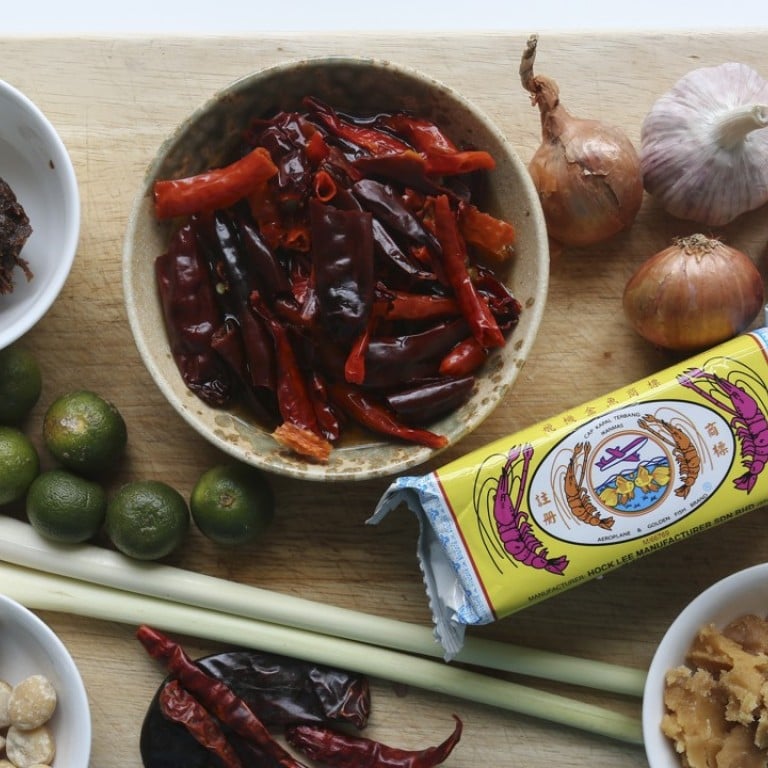
How to make sambal stingray at home – you don’t have to fly to Singapore to enjoy it
This recipe by Susan Jung rivals those served up at Southeast Asia’s celebrated hawker centres
I will be the first to admit that this version of sambal stingray isn’t quite as good as those you’ll find at hawker centres in Singapore and Malaysia. But it hits the spot when the craving kicks in – and for when I don’t have plans to visit those countries.
Stingray isn’t easy to find in Hong Kong, and I have successfully used the same cooking technique with a medium-sized pomfret.
Sambal stingray
It isn’t absolutely necessary to cook this with banana leaves, but it does make for more attractive presentation than aluminium foil. Frozen stingray (the only type I’ve found in Hong Kong) produces quite a lot of liquid as it cooks, which dilutes the flavour of the sambal. Because of this, I slather the sambal over one side of the fish and cook it, then blot up as much of the liquid as possible and flip the fish over onto a fresh banana leaf before slathering more sambal on that side, and cooking again. If you use fresh fish, you shouldn’t have this problem.
Traditionalists use a mortar and pestle to crush the sambal ingredients into a paste. I admire people who do this, but prefer to use a small blender (such as a NutriBullet).
For the sambal:
30 grams dried chillies (I use a mix of Thai bird’s-eye chillies and larger, slightly milder, Indian chillies)
30 grams seedless tamarind paste
300 grams Thai shallots
50 grams garlic cloves
3 large red banana chillies
2 stalks lemongrass
25 grams belacan (dried fermented shrimp paste)
15 grams macadamia nuts
50 grams palm sugar
5 grams fine sea salt, plus extra for sprinkling over the fish
100ml cooking oil, plus extra for oiling the banana leaves
For the sambal stingray:
1 piece of stingray, about 500 grams, defrosted, if frozen (or use a pomfret that weighs about 600 grams)
2 pieces of banana leaf, each approximately 25cm square
A few shallots
Fresh calamansi

Break the chillies in half and shake out and discard as many seeds as possible. Put the chillies in a bowl and add warm water to cover, then leave them to soften for about an hour. Drain the chillies.
Put the tamarind paste in a bowl and add about 60ml of warm water. Leave to soak until softened, about 15 minutes.
Roughly chop the shallots, garlic and banana chillies. Cut away the middle and top part of the lemongrass, leaving about 8cm of the lowest part of the stalk. Lay the lemongrass on a cutting board and use the side of a cleaver (or a meat mallet) to crush roughly. Finely chop the lemongrass.
Crumble the belacan and put onto a square of aluminium foil placed on a small, unoiled skillet. Put the skillet over a low-medium flame and cook the belacan until it smells toasted, stirring it occasionally.
Put the drained chillies, tamarind and the chopped shallots, garlic, banana chillies and lemongrass in a small blender (or mortar). Add the belacan, macadamia nuts and palm sugar. Grind the ingredients to a paste. You will probably need to mix in some water – just enough to moisten the ingredients. Occasionally stir the mixture so that it grinds evenly.
Scrape the mixture into a medium-sized wok and add the salt and oil. Place the wok over a medium-low flame and stir constantly until the ingredients start to simmer. Continue to cook, stirring constantly, until the oil floats to the surface. Take care, because the mixture will splatter. Adjust the heat so the sambal cooks at a low simmer. After it has cooked long enough, cool the sambal to room temperature.
Rinse the banana leaves then soak them in water for about 15 minutes. Dry the leaves then very lightly brush them with oil on both sides.
Take the thawed stingray from the fridge about 20 minutes before cooking. Use paper towels to blot up as much moisture as possible from the fish pieces, laying the towels on top and pressing down firmly to squeeze out excess liquid. Sprinkle salt over both sides of the stingray. Put the stingray fleshy side up on a banana leaf and slather generously with some of the sambal.
Heat a skillet (preferably of un-enamelled cast iron) over a medium-high flame. When it’s hot, put the stingray with the banana leaf into the skillet. Leave until you smell the banana leaf starting to toast then cover the pan with the lid. Cook for about six minutes then lift the banana leaf out of the skillet. If there’s a lot of liquid around the fish, blot up with paper towels.
Carefully flip over the fish onto the second banana leaf so that the bony side is up. Slather that side of the fish with sambal, then put back in the hot pan set over a medium-high flame. Cook the same way, but for about 10 minutes, or until the fish is done.
Slice the shallots into rings about 3mm thick and scatter the pieces over the fish. Cook, uncovered, for a minute, then lift the fish and banana leaf onto the serving plate. (Again, if there’s excess liquid around the fish, blot up with paper towels.) Squeeze some fresh calamansi over the fish then serve with more calamansi on the side.
The excess sambal should be scraped into a clean glass jar, pressing it in firmly to remove any air holes. If there’s not enough oil on the surface of the sambal, add fresh oil to cover it. Store in the fridge for up to a month. It can be used to stir-fry shrimp or squid.

